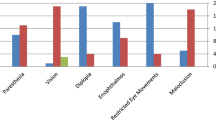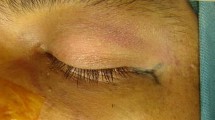Abstract
Introduction
Reduction of zygomaticomaxillary (ZMC) fracture is often difficult to evaluate intraoperatively because of it peculiar anatomy and limited accessibility. The purpose of this study is to evaluate the efficacy of use of C-arm as a tool for intraoperative monitoring of ZMC fracture reduction.
Materials and Methods
Group I (C-Arm) and Group II (control group) comprised of patients with isolated unilateral displaced Zygomatic complex (ZMC) fractures and having orbital volume change. The efficacy of use of C-arm intra-operatively was evaluated to analyse the reduction of fracture.
Results
It was observed that mean change in ocular volume was around 1.07cm2 for Group I and 1.51cm2 in Group II. Thus post-operative eye volume was near to normal in Group I than Group II. The change in ocular volume post-operatively was observed to be statistically significant (p-value < 0.05) in both the groups. Post HOC Tukey statistical analysis determined the intergroup relation in change in eye volume between normal, pre- and post-operative and was found to be statistically significant (p-value < 0.05). The intergroup comparison between Group I and Group II was done using ANOVA statistical analysis and was found to be statistically significant (p-value < 0.05).
Discussion
Our study revealed that C-arm is definitively an effective tool in the oral and maxillofacial surgery armamentarium, giving better results with minimal surgical exposure and by eliminating operator related error.




Similar content being viewed by others
References
Maheedhar AV, Ravindran C, Azariah ED (2017) Use of C-Arm to Assess Reduction of Zygomatic Complex Fractures: A Comparative Study. Craniomaxillofac Trauma Reconstr 10:35–43
Starch-Jensen T, Linnebjerg LB, Jensen JD (2018) Treatment of Zygomatic Complex Fractures with Surgical or Nonsurgical Intervention: A Retrospective Study. Open Dent J 12:377–387
Bogusiak K, Arkuszewski P (2010) Characteristics and epidemiology of zygomaticomaxillary complex fractures. J Craniofac Surg 2:1018–1023
Ellstrom CL, Evans GR (2013) Evidence-based medicine: Zygoma fractures. Plast Reconstr Surg 132:1649–1657
Farber SJ, Nguyen DC, Skolnick GB, Woo AS, Patel KB (2016) Current management of zygomaticomaxillary complex fractures: A multidisciplinary survey and literature review. Craniomaxillofac Trauma Reconstr 9:313–322
Kale TP, Balani A, Kotrashetty SM et al (2010) Intraoperative use of C-arm as an aid in the reduction of zygomatic complex fractures. World J Dent 1:13–16
Woolley EJ, Jones DC (2005) The use of the image intensifier in fractures of the zygomatic arc: A technical note. Int J Oral Maxillofac Surg 34:440–442
Peter Ward Booth. Maxillofacial Surgery (2nd ed) (2007) ;1:120
Liu X-Z, Shu D-L, Ran W, Guo B, Liao X (2013) Digital surgical templates for managing high-energy zygomaticomaxillary complex injuries associated with orbital volume change: a quantitative assessment. J Oral Maxillofac Surg 71:1712–1723
Sukegawa S, Kanno T, Furuki Y (2018) Application of computer-assisted navigation systems in oral and maxillofacial surgery. Japanese Dent Sci Rev 54:139–134
Heiland M, Schulze D, Blake F, Schmelzle R (2005) Intraoperative imaging of zygomatico maxillary complex fractures using a 3D C -Arm system. Int J Oral Maxillofac Surg 34:369–375
Bao T, Yu D, Luo Q, Wang H, Liu J, Zhu H (2019 Feb) Quantitative assessment of symmetry recovery in navigation-assisted surgical reduction of zygomaticomaxillary complex fractures. J Craniomaxillofac Surg 47(2):311–319
Wilde F, Lorenz K, Ebner AK, Krauss O, Mascha F, Schramm A (2013) Intraoperative imaging with a 3D C-arm system after zygomaticoorbital complex fracture reduction. J Oral Maxillofac Surg 71:894–910
Pedemonte C, Sáez F, Vargas I et al (2016) C-arm as intraoperative control in reduction of isolated zygomatic arch fractures: a randomized clinical trial. Oral Maxillofac Surg 20:79–83
Higgins A, Hurrell M, Harris R, Findlay G, David M, Batstone M. A study protocol for a randomised controlled trial evaluating the effects of intraoperative computed tomography on the outcomes of zygomatic fractures.Trials;2019 Aug 19;20(1):514
Hingsammer L, Seier T, Johner JP, Blumer M, Gander T, Rücker M, Wagner M. Does Zygomatic Complex Symmetry Differ Between Healthy Individuals and Surgically Treated Patients Using Intraoperative 3-Dimensional Cone Beam Computed Tomographic Imaging? J Oral Maxillofac Surg. 2020 May;78(5):798.e1-798.e7…
Hout WM, Van Cann EM, Koole R, Rosenberg AJ (2016 Nov) Surgical treatment of unilateral zygomaticomaxillary complex fractures: A 7-year observational study assessing treatment outcome in 153 cases.J Craniomaxillofac Surg. 44:1859–186511
Deveci M, Oztürk S, Sengezer M, Pabuşcu Y (2000) Measurement of orbital volume by a 3-dimensional software program: an experimental study. J Oral Maxillofac Surg 58:645–648
Markiewicz MR, Dierks EJ, Potter BE, Bell RB (2011) Reliability of intraoperative navigation in restoring normal orbital dimensions. J Oral Maxillofac Surg 69:2833–2840
Funding
None.
Author information
Authors and Affiliations
Corresponding author
Ethics declarations
Ethical Approval
Study Approved By Institutional Ethical Committee(ECR/BHU/Inst/UP/2013/Re-registration − 2017,ethical committee clearance no-Dean/2017-18/EC/1681.
Conflict of Interest
None.
Additional information
Publisher’s Note
Springer Nature remains neutral with regard to jurisdictional claims in published maps and institutional affiliations.
Electronic Supplementary Material
Below is the link to the electronic supplementary material.

Rights and permissions
Springer Nature or its licensor (e.g. a society or other partner) holds exclusive rights to this article under a publishing agreement with the author(s) or other rightsholder(s); author self-archiving of the accepted manuscript version of this article is solely governed by the terms of such publishing agreement and applicable law.
About this article
Cite this article
Srivastava, S., Tandon, S., Verma, V. et al. C-Arm a Useful Tool for Surgeons in Reduction of Zygomatic Complex Fracture: A Comparative Study. Indian J Otolaryngol Head Neck Surg 75, 379–384 (2023). https://doi.org/10.1007/s12070-022-03221-y
Received:
Accepted:
Published:
Issue Date:
DOI: https://doi.org/10.1007/s12070-022-03221-y




